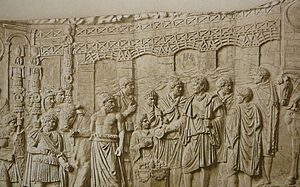Apollodorus of Damascus facts for kids
Quick facts for kids
Apollodorus of Damascus
|
|
|---|---|

Apollodorus of Damascus, bust from 130/140 AD in the Glyptothek
|
|
| Born | |
| Occupation | Architect |
| Buildings | Basilica Ulpia, Trajan's Forum, Temple of Trajan |
Apollodorus of Damascus (Ancient Greek: Ἀπολλόδωρος ὁ Δαμασκηνός) was a famous architect and engineer from Damascus, Roman Syria. He lived around the 2nd century AD. He was known for his amazing building projects and technical writings.
Apollodorus is one of the few ancient architects whose name we still know today. He brought new ideas from the East into Roman building styles. For example, he helped make the dome a common feature in Roman architecture.
Early Life and Career
Apollodorus was born in Damascus, Syria, around 50 to 70 AD. At that time, Damascus was either ruled by the Nabataeans or had many Nabataean people living there. Apollodorus himself is thought to have been of Nabataean background.
Not much is known about his early life. He started his career as an engineer for the military. Later, he met Trajan in Damascus, who would become a Roman emperor. Trajan then asked Apollodorus to come to Rome. Apollodorus even joined Trajan during the Second Dacian War in 105 AD.
Amazing Roman Buildings
Apollodorus became Emperor Trajan's favorite architect and engineer. He designed and oversaw many huge building projects.
In the city of Rome, he helped create the impressive Forum of Trajan. This included the Markets of Trajan, the Temple of Trajan, and the famous Trajan's Column. The column was the first monument of its kind. He also designed the Stadium of Domitian in Rome.
Outside of Rome, Apollodorus built important structures. He constructed bridges across the Danube River and the Tagus River in Spain. He also designed the grand triumphal arches of Trajan in Benevento and Ancona. Apollodorus also wrote a book called Siege Engines, which was about military machines.
Building Style
Experts say that Apollodorus's great building skills came from his background in Syria. His mastery was influenced by Nabataean culture and Greek ways of thinking.
He was known for making strong and practical designs. It is believed that he played a big part in making domes a regular part of Roman buildings.
Later Life
According to some historical accounts, Apollodorus had a disagreement with Emperor Hadrian. Hadrian was also interested in architecture, but Apollodorus reportedly made fun of his ideas. This led to Apollodorus being sent away from Rome. Some stories even say he died because of this. However, historians still discuss if these accounts are fully true.
See also
 In Spanish: Apolodoro de Damasco para niños
In Spanish: Apolodoro de Damasco para niños


